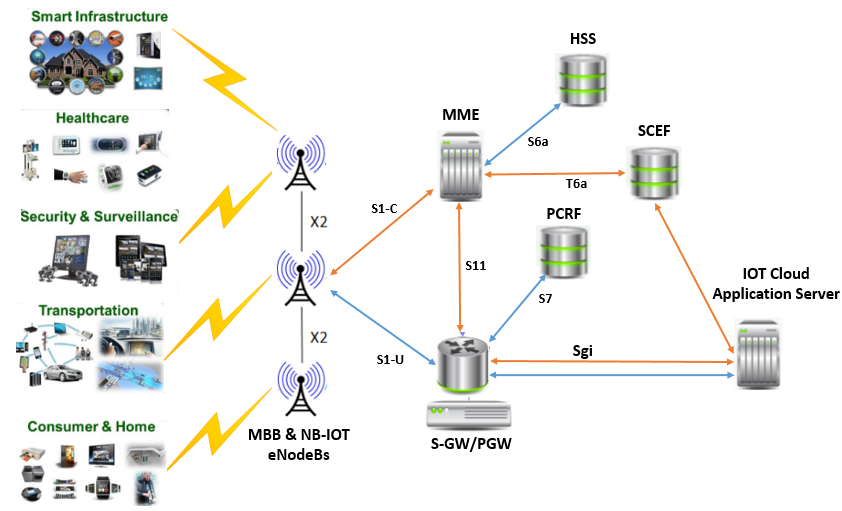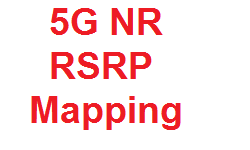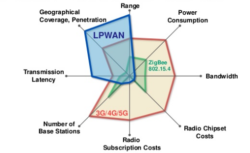Narrow Band LTE- NB-IoT
NB-IoT or NB-LTE is a new 3GPP radio-access technology. It is not fully backward compatible with existing 3GPP devices however it is designed to achieve excellent co-existence performance with legacy GSM, GPRS and LTE technologies. NB-LTE requires 200 kHz minimum system bandwidth for both downlink and uplink, respectively. The choice of minimum system bandwidth enables a number of deployment options like a GSM operator can replace one GSM carrier (200 kHz) with NB-IoT or a LTE operator can deploy NB-LTE inside an LTE carrier by allocating one of the Physical Resource Blocks (PRB) of 180 kHz to it. This minimum bandwidth 200 KHz requirement enables three possible modes of operation of NB-LTE which are mentioned as below and illustrated in figure.
- In-band Operation using one PRB of a LTE carrier
- Guard band Operation by using used Resource Blocks within LTE carrier Guard Band
- Standalone Operation by using a GSM 200KHz carrier

NB-IoT reuses the conventional LTE design extensively, including the numerologies, downlink OFDMA, uplink SC-FDMA, channel coding, rate matching, interleaving, etc. This significantly helps to reduce the time required to develop full design specifications. Also, it is expected that the time required for developing NB-IoT products will be significantly reduced for existing LTE OEMs and ODMs.
NB-LTE also use the same Networks architecture as of conventional LTE Network with some optimization required to support IoT Massive user requirements. The basic architecture for NB-LTE is shown in below and similar to LTE network consist of two part namely Access Network and Evolved Packet System (EPS) Core Network. In access network architecture there is no change, but at Core network the both user plane and control plane, some other optimizations are done to support IoT application. A new node has been introduced as SCEF (Service Capability Exposure Function). The SCEF is designed especially for machine type data. It is used for delivery of non-IP data over control plane and provides an interface for the network services (authentication and authorization, discovery and access network capabilities).

A list of common optimizations required for IoT support at EPS are listed below:
- On the Control Plane, UL data can be transferred from the eNB to the MME. From there, it may either be transferred via the Serving Gateway (SGW) to the Packet Data Network Gateway (PGW), or to the Service Capability Exposure Function (SCEF) which however is only possible for non-IP data packets. From these nodes, they are finally forwarded to the application server or IoT Services. The same is depicted by Orange line. DL data is transmitted over the same paths in the reverse direction. This approach does not require radio bearers, data packets can be sent on the signaling radio bearer instead. Consequently, this solution is most appropriate for the transmission of infrequent and small data packets.
- With the User Plane EPS optimization, data is transferred in the same way as the conventional data traffic, i.e. over radio bearers via the SGW and the PGW to the application server. Thus, it creates some overhead on building up the radio bearer connection, however it facilitates a sequence of data packets to be sent. This approach requires supports delivery of both, IP and non-IP data packets with EPS.
- Another possible optimization can be done for reducing signaling by guiding IoT devices to perform periodic location updates less frequently and by optimizing paging. Reducing signaling can help avoiding overload situations in massive device network.
- Subscriber data storage handling in the HSS also need to be optimized to support a large number of IoT.
Detailed information about NB-IoT can be found in this paper.
Related Post:
- Narrow Band IoT
- Narrow Band IoT Frequency Bands
- Narrow Band IoT Frame Structure
- Narrow Band Synchronization Signals (NPSS and NSSS)
- NB-IoT PRBs (Physcial Resource Blocks) for In-Band Operation
- Narrow Band IoT- Signalling Radio Bearers (SRBs)
- Narrow Band-IOT UE Attach Call Flow Messaging
- Cat. NB1 and Cat. NB2 Devices Comparison



